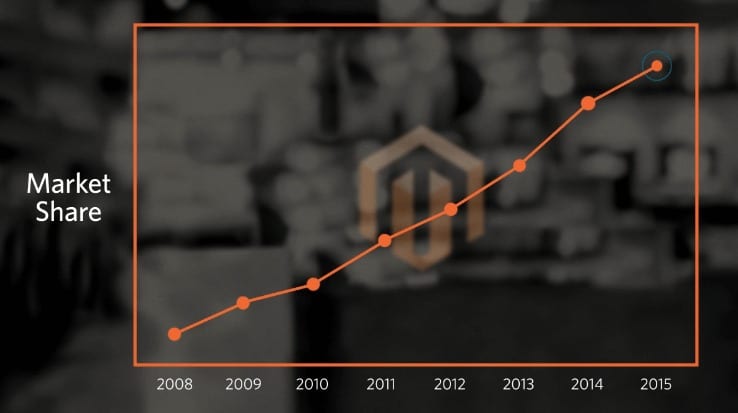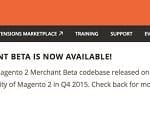Magento 2, after initially being announced back in 2010, has now been released for over three months, promising to empower brands, retailers and businesses, offer enhanced performance and scalability, boost conversion rates and introduce unmatched levels of flexibility and innovation opportunities. There is no doubt that it offers improvements on Magento V1, but is now the right time to move to Magento 2? We explore this question below.
Magento 2 vs 1.9: What Are the Differences?
When designing Magento 2, Magento didn’t just tweak a few features from the previous module, they have quite literally stripped down the whole software to its roots and built it back up from scratch to make it quicker, easier and safer than its predecessors. Customers and clients alike have been waiting patiently but attentively since the original announcement back in 2010, after which time it was delayed until being picked back up in 2011. This time in development until its release has led to numerous speculation articles and blog posts on just what Magento 2 would do differently to Magento V1.
We knew from Pre-Beta stage that Magento were going to be offering streamlined customisation processes, more scalability, easier installation, a more mobile responsive system and general all round improvements on speed and use, both customer and client side. eBay, having taken over Magento in 2011 and continuing with the project, envisioned Magento 2 to be the next-gen eCommerce platform designed to give developers a much better toolset in creating innovative solutions to help accelerate market growth.
Now that Magento 2 has been released we can see that eBay kept true on their promise with an extensive overhaul of the software jam-packed with features. Some of these improvements, but not all, are listed below:
- Checkout – some minor tweaks, such as assumed guest checkout and automatic recognition of customers based on emails of registered users.
- Product Import/Export – now processes 100K records in 25 minutes.
- Performance & Scalability – both server side and client side improvements, with features like increased layout performance, full page caching for faster speeds and effective image compression. Scalability has been vastly improved with Magento 2, with improvements to both the Enterprise Edition (MEE) and Community Edition (MCE) in all areas; Catalogue, Checkout and Backend. The Catalogue area can now handle up to 10million page views per hour with Varnish, 1.5million simple products and 5000 categories. Checkout can now process 50,000 orders per hour with MC or 90,000 per hour with ME and Backend now has increased functions also, including 50+ product management with deferred product updates.
- Migration – extendable migration tool to allow for simpler migration from Magento 1 to Magento 2, which is compatible with both ME (1.11-1.14) and MC (1.7-1.9).
- New Magento Connect – it is now easier to upload, sell and track for developers, there is improved search and quality, automated scans for plagiarism have been introduced as well as code safety for vulnerabilities and coding standards.
The above list is just a few of the highlights from the extensive list of updates in Magento 2, the full version of which can be found in a video released by Magento here prior to the release of M2: https://attendee.gotowebinar.com/recording/2273738737246227458.
On the whole, Magento have gone for improved performance with faster speeds, a flexible new architecture powered by an entirely new, next-generation system, more engaging customer shopping experiences, increased business agility and of course, robust security. They also offer flexibility with payment processes, supporting PayPal, Braintree and Authroize.net payment gateways. The official Magento announcement for the release of Magento 2 can be found here: https://magento.com/blog/magento-news/new-era-commerce-innovation.

Magento’s modern tech stack – magento.com
Is Magento 2 Stable?
Magento 2, having been in development for a number of years now, has been through rigorous and exhaustive quality assurance and testing by both their in-house teams as well as external testers. The beta version, released last year, was used to fully vet the software on a wider scale and test in real-world settings and conditions, thereby putting it through further quality assurance and testing.
During it’s ‘Merchant Beta’ phase, Magento partnered with 15 merchants worldwide who implemented the new Magento 2 platform. Some of these merchants include Alcatel Onetouch (http://www.alcatelonetouch.us), SEAT (https://shopworld.seat.de) and Venroy (https://www.venroy.com.au) who still use the software and the results of this can be seen by following the links. These are popular, household name brands, processing thousands of pounds worth of orders everyday, and so stability would have been a priority for them when testing this software and eventually implementing it.
Full page caching, alongside the other improvements to scalability, lend to a much more stable and reliable system. Magento’s decision to build 2 from the ground up, rather than just adding improvements, was done with stability in mind. Using state-of-the-art tech in the form of HTML 5 and a revamped CSS pre-processor, coupled with a more user-friendly customisation process and an easier time installing updates results in a more stable, more efficient system.
While there may be some minor issues at the early release of Magento 2, as with any early-release software, V2 has been tested and re-tested both in-house and on the open market, and has only been released to the public after extensive testing deemed it ready.

Some of Magento’s upgraded areas – magneto.com
Pros and Cons of Moving to Magento 2 at the Current Time
Some articles, such as http://ecommercenews.eu/magento-2-finally-still-relevant weren’t convinced of the benefits of Magento 2 when further details were released last year.
The article quotes Danny Decker from Pre-Beta release, partner of interactive agency Harlo Interactive, who said that he has tested Magento 2, in one of its earlier forms, and believes it is nothing more than a rewrite with jQuery, offering nothing different to Magento V1. According to him Magento 2 does great things for developers, but doesn’t do a great deal for the merchants. However, this comment was made over a year ago, and many of the issues he alludes to seem to have already been resolved.
After years of development Magento 2 is much easier to use, more accessible, fast and more versatile, marking a vast improvement on Magento 1. There is no right or wrong answer when it comes to switching to Magento 2 at this time, especially with opposing opinion pieces like above, but quite simply Magento 2 is a vast improvement on Magento 1. While it may still need some minor, or maybe even major tweaks, it is a system that already has planned development periods and software updates and Magento welcome feedback from the community. While the system is brand new and suffers from minor issues like any new system does, this is far outweighed by the fact that this system is built in with all the new innovative, modern and user-friendly features available, all with the power of Magento as market leaders and eBay’s investment behind it. Some may choose to stay with V1 for peace of mind until things have settled down with V2, but V1 is now ‘outdated’, and will generally be phased out over the coming months.
Things You Need to Consider
Magento 2, whatever the various opinions on it at this moment in time, has still been released by Magento, an extremely, if not the most, popular eCommerce software company on the market. With an open source character, varied possibilities and large user and development base, Magento is sure to be up there with the best shopping platforms, and this is supported by its client-base, boasting such companies as Nike, Christian Louboutin, Harper’s Bazaar and OfficeMax.
However, Magento 2 hasn’t been without its fair share of controversies and problems. It was originally announced in 2010 by Yoav Kutner, Magento’s Co-Founder and then CTO, when he commented that Magneto V1 is now mature enough to require a new version. Six years later, in an increasing digital world where staying ahead of the competition requires constant innovation before a fresh startup takes over, it has only just been released. New players have since emerged offering similar features to Magento 1, especially ones like WooCommerce with its ease of usability, and some seem prepared for the future with mobile and social features already implemented in their software.
In 2011 eBay acquired Magento and Yoav quit less than a year later, citing in a comment, which has since been deleted, that he believes that the people at eBay don’t seem to understand the meaning of open, and as such he’d be interested to see if Magento stays open in the way that it was meant to. Was the vision for Magento 2 lost along the way?
Regardless of the in-house politics that may have occurred over the years, it is the features that have been released that matter to both the client and the customer. As Magento 2 has only just been released, users who migrate now are similar to ‘testers’ on a much larger scale, and some current known issues are listed here: (https://github.com/magento/magento2/issues).
But while Magento 2 is still in its ‘baby stage’ in terms of release, it has been under development for over four years. The investment and power behind it is enormous, and it has already been cited by some as revolutionising the payment and online shopping industry. Alongside this, the risks of not migrating now are that newer extension functionalities will not work with older versions, as well as the fact that these older versions may be at risk of security flaws or outdated server architecture requirements. For example, earlier versions of Magento no longer work on the newer version of PHP.
As a note, the Magento team have said that they do plan on continuing to support Magento V1 for another three years from the moment of 2’s release, which was in Q4 of 2015, but it will slowly be phased out along the way.

A rough graph display Magento’s market share over the last few years – magento.com
Are You Already Using Magento and Should You Upgrade?
There are always risks when upgrading or migrating to new software or updates early on; you are essentially the first group of testers on a wider scale after the initial tests with smaller groups and in-house testing has been completed. It is generally in this stage when some bugs and issues can arise. However, as mentioned above, it has been rigorously tested over a number of years and the benefits of 2 already outweigh the cons of the older, outdated versions. This isn’t like an Apple iOS update where a new version is out every year to keep up with the competition; Magento have been building and testing this for a long time.
Magento have said that 2 will feel familiar to the original Magento platform, but that users will still need some training in order to get the most out of it. They have created a white paper for those wishing to know more about making the switch from M1 to M2, which can be seen here: (https://magento.com/resources/magento-2-migration-whitepaper).
Unlike smaller CMS systems like WordPress, Magento is very complex and the migration process is not simple. Magento is aimed at larger companies, typically with an online turnover of more than £100,000 a year, and so the likelihood is that these websites process hundreds, if not thousands of transactions per day. Therefore, these companies cannot afford to process the migration offline and switch sites in case they lose new customers and of course, valuable profit.
If you aren’t quite ready to make the switch to Magento 2, it is a priority that at the very least you are using Magento 1.9, as earlier versions are at risk of security flaws and outdated processes. Your system will also need to be updated to 1.9 before you can then upgrade to 2, which in itself can be costly and timely, but will need to be completed eventually.
Are You New to Magento?
In many ways, clients who are looking to build a brand new Magento site will find it easier to simply start with 2 rather than having to upgrade or migrate an old one, and V2 is showing a lot of promise. Although it isn’t completely established yet, it does seem to mark a new era of commerce innovation, and the features offered compared to the older V1 module lead some to argue that it is worth starting with this version.
As it will eventually become compulsory to upgrade to Magento 2 as V1 is slowly phased out, setting up a new Magento V1 system now will require migration within potentially the next year, and so could be extremely costly in terms of both money and time in such a short space of time, so it is recommended to set up your new eCommerce project with Magento 2.
Availability of Extensions and Themes for Magento 2
As Magento 2 is still in its early stages, may of the third party themes and extensions are not yet available, and as much of the functionality facilitated by third party extensions in the 1.X branch is not yet available in 2 some companies may decide to wait until 2 is more established.
However, this is rapidly changing and it is an ever-growing marketplace. Some third party extensions already available include: MageMonkey for email capture & newsletter services like MailChimp, Pinterest Rich Product Pins, an integration module for Pinterest, Facebook Connect as well as Twitter & Facebook Login, McAfee SECURE, Brand Slider and Apply Coupon Code Link. For a full list of available extensions see – https://www.magentocommerce.com/magento-connect/magento-2.
Magento 2 Roadmap for Future Developments
Magento 2 has only just undergone its Merchant General Availability phase at the end of 2015, but Magento have already cited ongoing release stages for 2016, with at least one a quarter, as can be seen from the ‘Release Approach’ below.
Magento 2.1 has already been released, offering compatibility with PHP 7.0.2 to offer dramatic performance improvements, reduction in memory consumptions and support for new PHP language features. There are added security enhancements despite the fact that there are no confirmed attacks on Magento 2 as of this stage. Some of these security fixes include SQL injection, the ability for unauthenticated users to delete any product review from the storefront and stopping attackers being able to access order information in the store. The full release notes can be seen here: (http://docs.magento.com/m2/ce/user_guide/magento/release-notes-ce-2.1.html).
This information was taken from a slideshow presented pre-General Availability, and can be seen here: (http://www.slideshare.net/Amasty/meet-magento-belarus-elena-leonova).
Mageno 2 Demos and Examples
As mentioned earlier, during its ‘Merchant Beta’ phase, Magento 2 had 15 merchants worldwide who implemented the new 2 platform, and examples of this can be seen with Alcatel Onetouch (http://www.alcatelonetouch.us), SEAT (https://shopworld.seat.de) and Venroy (https://www.venroy.com.au).
There is also a current live demo version available here: http://magento2demo.firebearstudio.com/.
Previous articles in the series
- Magento 2 Merchant Beta is Now Available for Download
- An Update about Magento 2, When Will This Be Available?
How We Can Help
All in all, we believe that now is the right time to switch to Magento 2. The improvements from V1 are vast, and while there are still some small minor issues that need ironing out, the improved scalability, ease of use and customer experience lends to a much better all round system perfect for any brand looking to take their online commerce to the next level. The system has been thoroughly tested over a number of years, and with the finance of eBay behind it, it has ensured that Magento are still the go-to brand when it comes to eCommerce platforms, which is why it empowers over 200,000 online retailers and is chosen by one in every four of online businesses.
Migrating or upgrading can at first be a confusing process, but our experienced team of Magento developers are on hand to take you through the upgrade process from installation and configuration to testing and troubleshooting. If you’re interested in using our upgrade service in the near future or need help understanding a little bit more about the various Magento packages on offer and what they do, feel free to get in touch online, call on 0121 371 0435 or [email protected] and discuss it with our developers.

A selection of our older posts, written by various members of the team between 2015 to 2021.








0 Comments